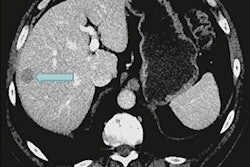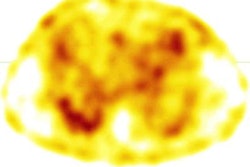
PET with a gallium-68 (Ga-68) prostate-specific membrane antigen (PSMA)-11 radiotracer should be the standard imaging modality for guiding stereotactic ablative radiotherapy (SABR) in oligometastatic prostate cancer patients, according to a June 29 study in Clinical and Translational Radiation Oncology.
Dutch researchers compared outcomes in patients treated with SABR based on either Ga-68 PSMA-11 PET or choline-PET. They found response and survival rates were higher in the Ga-68 PSMA-11 group.
"PSMA-11 PET is still not the standard imaging modality for this group of patients in many countries and therefore comparing the treatment outcomes between choline-PET and PSMA-11 PET is of high clinical interest," wrote Dr. Charlotte Deijen, PhD, and colleagues at the Netherlands Cancer Institute in Amsterdam.
Standard treatment for patients with oligometastatic recurrent prostate cancer is androgen deprivation therapy (ADT). ADT has many potential side effects that may result in impaired quality of life.
Meanwhile, SABR is emerging as an effective alternative to ADT. Because Ga-68 PSMA-11 has a higher sensitivity than choline-PET, the authors hypothesized that SABR results based on Ga-68 PSMA-11 PET could result in improved outcomes and subsequently delay the need to start ADT.
In this retrospective evaluation, the researchers enrolled 50 patients with a total of 72 metastatic prostate cancer lesions who were treated with SABR between January 2012 and December 2017 at the Netherlands Cancer Institute. All images were acquired using an integrated PET/CT scanner.
Metastases were visualized in 40 patients by Ga-68 PSMA-11 and choline-PET was used in 10 patients. The primary endpoint was ADT-free survival, defined as the time between start of SABR and start of ADT.
Ga-68 PSMA-11 PET enabled SABR eligibility of patients with lower PSA levels than choline-PET. Also, patients imaged with Ga-68 PSMA-11 experienced a significantly longer response of 34 months compared with 14.7 months in patients imaged by choline-PET. Subsequently, the Ga-68 PSMA-11 group had a longer ADT-free survival of 32.7 months versus 14.9 months.
"This study shows that PSMA-11 PET improves selection of patients with oligometastatic prostate cancer suitable for SABR by detection of metastases in an earlier stage at lower PSA levels compared with choline-PET. Subsequently, PSMA-11 PET-guided SABR resulted in a significant longer response duration and ADT-free survival than in patients whereby the metastases were localized by choline-PET," the authors stated.
Several studies have reported on ADT-free survival after SABR with use of choline-PET, while similar data for Ga-68 PSMA-11 PET are scarce, according to the authors. They noted this is the first study to their knowledge to compare Ga-68 PSMA-11 PET and choline-PET for clinical outcome in terms of ADT-free survival in patients.
Moreover, despite the approval of Ga-68 PSMA-11 in the U.S. and Europe for prostate cancer imaging, as well as other recent imaging advances in the detection of both primary and metastatic prostate cancer, PET imaging is not currently routinely recommended for the detection and staging of prostate cancer.
"As choline-PET is still widely used for detection of prostate cancer recurrence, much can be gained with the use of PSMA-11-PET," the authors concluded.





















